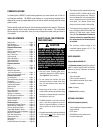
NOTE: DIAGRAMS & ILLUSTRATIONS ARE NOT TO SCALE.
WARNING
When using a gas burner, it is
mandatory to keep the chimney
outside air register opened.
6
Failure to use LHP parts or conduct variations
in techniques and construction materials
described in this installation manual may
create a serious fire hazard and may void
the warranty and the WHI listing.
3. Always check your local building codes.
The installation must comply with their
regulations. Before beginning the instal-
lation, consult the local authorities and
make sure your building permit complies
with their requirements.
4. This fireplace must be installed with Security
Chimneys™ chimney system models ASHT+,
S-2100+ or AC, of 8" inside diameter. These
systems are intended for use in any applica-
tion where a traditional masonry type fireplace
would apply. The chimney system must
always vent to the outside of the building.
5. To maintain top efficiency and to prevent
build-up of soot and creosote, inspect and
clean the chimney periodically during the
heating season.
6. To prevent possible hazards due to poor
combustion and to avoid affecting other fuel
burning appliances (furnace, wood stove,
etc.), ensure that the outside air kit is properly
installed.
7. This fireplace is designed to allow the instal-
lation of a gas burner. In such a case, the
installation must conform with the National
Gas Code ANSI Z223.1 and Z21.60.
9. The ME43 fireplaces are sold with factory
installed doors. The outside combustion
air kit is mandatory and is included with the
fireplace. Optional blowers and decorative
trims are available.
Tools And Building Supplies Normally
Required
Tools:
Phillips screwdriver
Slot style screwdriver
Hammer
Saw and/or Sabersaw
Level
Measuring tape
Plumb line
Electric drill and bits
Pliers
Square
If gas pipe is used:
Pipe wrench
Pipe cutter
Pipe threader
Pipe joint compound
Pipe key valve
Building supplies:
2" x 3" or heavier lumber
Drywall panel or equivalent
Silicone caulking (non-combustible)
Overlay material for fireplace façade
Hearth extension (non-combustible)
PRECAUTIONS!
The most important areas of concern dealing
with the fireplace installation are clearances
to combustible materials, secure assembly of
components parts, the height of the chimney
system, the proper use of accessory equip-
ment and the techniques used in using finish-
ing materials applied to fireplace surrounds,
hearth extensions and wall coverings. Each
of these topics will be covered in greater detail
throughout this manual. Please give special
attention to these instructions as you progress
with your installation.
Fireplace Installation Procedure
1. Move the fireplace into the desired position
(follow the recommendations below for
enclosure).
8. This fireplace has provision for the installa-
tion of a gas pipe and is intended only for
connection to a decorative gas appliance
incorporating an automatic shutoff device
and complying with ANSI Z21.60-M96/CGA
2.26-M96, Standard for Decorative Gas Ap-
pliances for Installation in Solid-Fuel Burning
Fireplaces (reference Clause 4.1.3 T).
2. Install the outside air assembly (or assem
-
blies) - refer to Page 8.
3. Install the enclosure surrounding the fireplace
(refer to the sections “Enclosure” below and
“ Facing and Mantel” on Page 7).
4. Install the hearth extension (see Page 8).
Make sure the gap between the fireplace and
the hearth extension is sealed.
LOCATING THE LENNOX FIREPLACE
Do not place the fireplace on carpeting, vinyl
or other soft surface floor coverings. It may,
however, be directly placed on flat wood,
plywood, particle board or other hard surface
materials.
ADJACENT WALL
A wall perpendicular to and in front of the fire-
place front facing must be at least 18" (460mm)
from the fireplace opening. A wall at 45º to the
front facing and starting at the fireplace’s outer
edge is permitted. Projections within this area
are permitted. See Figure 4.
Figure 4
OPENING
WALL
FIREPLACE
STANDOFFS
18"
(460mm)
45°


















